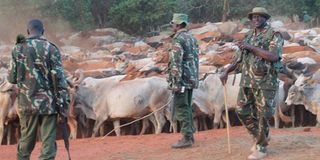Illegal herders or drought survivors?

Police guard cattle seized at Ole Naishu Ranch in Laikipia County over illegal grazing.
The deadly violence in Laikipia County has seen nomads looking for pasture in farms and wildlife conservancies around it given all sorts of names.
To some, they are bandits, illegal herders, attackers, invaders and so on — but not a group of people looking for sustenance in the form of pasture and water for their livestock as drought ravages parts of the country, yet again.
Movement of nomadic communities from the North and parts of Rift Valley to other areas is a normal pattern witnessed during drought. They cross into neighbouring countries, not just bordering counties, in search of grass and water.
Conflict over meagre resources during the dry season is not limited to Laikipia; it’s also experienced along the borders of the neighbouring countries of Ethiopia, South Sudan and Somalia.
Cattle rustling during drought is common; it’s among the survival tactics employed by the communities to replenish lost livestock such as cattle and camels.
How do I know this? Because I’m a product of a nomadic community and hear and see the struggles of my people.
Nomads
To the nomads, as anyone else, it’s incomprehensible to see their cattle die when they know they can move to the proverbial ‘greener pastures’ to save their animals and themselves. They understand when to turn south and east before returning north once the rains start again, signalling better times closer to home.
I once made a joke while walking through Hyde Park, London, with a friend that it was a complete waste to see all the grass just used to seat people for leisure when they could graze cattle on it. Years later, an English friend told me about the history of a park that was grazing lands but was changed to provide recreational services — because those who built houses around the grazing lands complained that the cattle were destroying their roses!
Laikipia seems to suffer from a similar identity crisis: Lands that were historically used as shared grazing lands changed hands in the 19th century to make way for European settlers, who fenced them off. The nouveau conservancy owners — some of whom had just arrived in the country, whose only purpose was to entertain a handful of tourists at the expense of thousands of nomadic people and their livestock — joined the fray in grabbing Laikipia lands and fenced theirs too.
The higher they put up the fences, the more they squeezed the life out of nomadic communities, who were left between patched lands up north and the barbed wire (often electric) fences of green Laikipia. The anger from the herders is to be expected as a hungry man is an angry man.
Far-reaching implications
The solution in Laikipia is not militarisation or politicisation of the problem. That will only make things worse as the traditionally armed herders are not going to sit on their haunches and see their animals die but fight fire with fire. It’s easy to blame the local politicians; they are, understandably, under pressure to protect their communities from starvation.
The impact of drought has far-reaching implications for the socioeconomic status of the concerned areas. It leads to higher rural-urban migration during drought as men who lose their animals move to towns to look for work as security guards or handymen to fend for the families they left behind. But the urban lifestyle ends up being harder than even the rustic one they had been forced to abandon.
In addition, such migration adds to an unsustainable population boom in major towns and cities and to a large degree contributes to an increase in underclass societies. The expansion of urban informal settlements over the years was not by accident but partly attributable to poor management of drought, whereby people are forced to flee rather than be supported to remain in their rural home counties.
Wildlife movement
Kenya has one of the most well-known corridors for wildlife movement. Perhaps, that allows for such animals to move freely across the country to look for food and water. Only recently, there was hue and cry over the establishment of an avocado farm in Amboseli National Park which, it was felt, threatened a wildlife migration corridor. We need a similar scheme to help nomadic communities to access grazing lands for their animals during drought.
The dry season is part and parcel of Kenya’s ecological pattern and did not only come about with the recent concerns over climate change. Neither would famine be resolved without progressive measures being put in place to mitigate humanitarian disasters during droughts.
Instead of giving biased security to conservancy owners, the government should make them share resources with herder communities when times are hard, such as during the dry season. The Gypsy communities in Europe (who are of nomadic lineage) enjoy protection from governments and are allowed to share spaces and resources with sedentary communities.
The same model can be applied in Kenya. The government has a legal and moral duty to ensure that, that happens.
[email protected]. @kdiguyo





